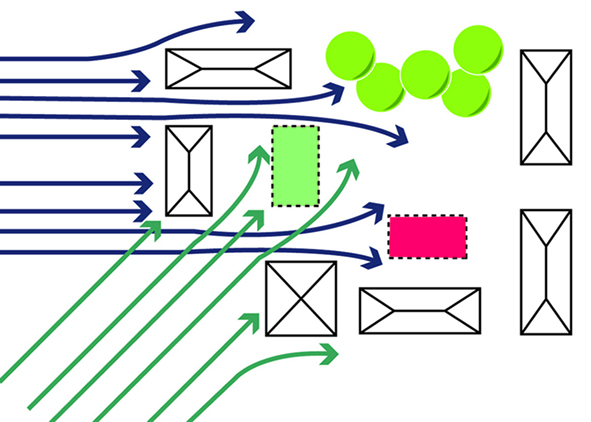Design and complexity. A multiscale approach for updating the project’s control tools
DOI:
https://doi.org/10.19229/2464-9309/7162020Keywords:
multiscale approach, environmental design, technological design, innovative materials and products, performance controlAbstract
In the current situation, it is necessary to propose an integrated, multiscale and multidisciplinary approach to manage the complexity of the architectural project, identifying decision support tools to perform multicriteria assessments between technical performance and different environmental criteria. This contribution presents the results of research activities undertaken in the framework of a PRRIITT within the Department of Architecture of the University of Ferrara, with the collaboration of the Larco Laboratory – High Technology Network of the Emilia Romagna Region and various companies, for the development of a method able to evaluate in a provisional way and during the design phase the different environmental quality components generated by the technological system, overcoming today simplification intrinsic in current assessment and certification models.
Downloads
Article Metrics Graph
References
Cagnoli, P. (2017), “Metabolismo urbano e strategie di sviluppo”, in Ecoscienza, n. 5, pp. 76-78. [Online] Available at: www.arpae.it/cms3/documenti/_cerca_doc/ecoscienza/ecoscienza2017 _5/cagnoli_es2017_05.pdf [Accessed 21 April 2020].
Canepa, M. (2018), Riflessioni sullo sviluppo sostenibile a trent’anni dal Rapporto Brundtland, Mimesis Edizioni, Milano.
Chandratilake, S. R. and Dias, W. P. S. (2013), “Sustainable rating Systems for buildings – Comparison and correlations”, in Energy, n. 59, pp. 22-28.
Conato, F. and Cinti, S. (2014), Architettura e Involucro, BE-MA Editrice, Milano.
Conato, F. and Frighi, V. (2016), Metodi della progettazione ambientale – Approccio integrato multiscala per la verifica prestazionale del progetto di architettura, FrancoAngeli Editore, Milano.
Dalla Valle, A., Lavagna, M. and Campioli, A. (2016), “Change management and new expertise in AEC firms: improvement in environmental competence”, in Barreto Tadeu, A. J. (ed.), 41st IAHS Wold Congress on Housing, Sustainability and Innovation for the Future, September 13-16, 2016, Albufeira, Algarve, Portugal – Proceedings, International Association for Housing Science, Algarve, pp. 1-10. [Online] Available at: core.ac.uk/download/pdf/80336704.pdf [Accessed 5 March 2020].
Florez, L. (2020), “Sustainability and Green Building Rating Systems: A Critical Analysis to Advance Sustainable Performance”, in Encyclopedia of Renewable and Sustainable Materials, vol. 4, pp. 211-220.
Ganassali, S., Lavagna, M. and Campioli, A. (2016), “Valutazione LCA all’interno dei protocolli ambientali multicriteri per il settore delle costruzioni”, in Dominici Loprieno, A., Scalbi, L. and Righi, S. (eds), Atti del X Convegno dell’Associazione Rete Italiana LCA 2016 – Life Cycle Thinking, sostenibilità ed economia circolare, Ravenna, 23-24 Giugno 2016, ENEA – Servizio Promozione e Comunicazione, Frascati, pp. 415-422. [Online] Available at: www.enea.it/it/seguici/pubblicazioni/pdf-volumi/atti-rete-lca-2016.pdf [Accessed 21 April 2020]
Gaspari, J., Trabucco, D. and Zannoni, G. (2010), Involucro edilizio e aspetti di sostenibilità – Riflessioni sul comportamento energetico di pareti passive e stratificate superisolate: performances ambientali ed embodied energy, FrancoAngeli, Milano.
Lavagna, M., Bessi, A., Meneghelli, A. and Moschini, P. (2019), “La dimensione ambientale del progetto esecutivo – Esperienze e prospettive future | The environmental dimension of detailed design – Experiences and future perspectives”, in Techne | Journal of Technology for Architecture and Environment, vol. 18, pp. 138-146. [Online] Available at: doi.org/10.13128/techne-7520 [Accessed 5 March 2020].
Losasso, M. (2017), “Progettazione ambientale e progetto urbano”, in Eco Web Town | Journal of Sustainable Design, n. 16, vol. II, pp. 7-16. [Online] Available at: www.ecowebtown.it/n_16/pdf/16_02-losasso-it.pdf [Accessed 17 January 2020].
Losasso, M. (2016), “Climate risk, Environmental planning, Urban design”, in UPLanD | Journal of Urban Planning, Landscape & Environmental Design, vol. 1, issue 1, pp. 219-232. [Online] Available at: doi.org/10.6092/2531-9906/5039 [Accessed 5 March 2020].
Marino, V. and Thiébat, F. (2019), “Integrazione dei requisiti di sostenibilità ambientale nel progetto di architettura | Integration of sustainability requirements in architectural design”, in Techne | Journal of Technology for Architecture and Environment, vol. 18, pp. 174-183. [Online] Available at: doi.org/10.13128/techne-7524 [Accessed 5 March 2020].
Schiaffonati, F., Mussinelli, E. and Gambaro, M. (2011), “Tecnologia dell’architettura per la progettazione ambientale – Architectural technology for environmental design”, in Techne | Journal of Technology for Architecture and Environment, vol. 1, pp. 48-53. [Online] Available at: doi.org/10.13128/Techne-9434 [Accessed 17 January 2020].
Tucci, F. (2014), Involucro, Clima, Energia, Qualità bioclimatica ed efficienza energetica in architettura nel progetto tecnologico ambientale della pelle degli edifici, Altralinea Edizioni, Firenze.
United Nations (1987), Our Common Future – Report of the World Commission on Environment and Development. [Online] Available at: netzwerk-n.org/wp-content/uploads/2017/04/0_Brundtland_Report-1987-Our_Common_Future.pdf [Accessed 20 April 2020].
Vierra, S. (2019), Green Building Standards and Certification Systems. [Online] Available at: www.wbdg.org/resources/green-building-standards-and-certification-systems [Accessed 20 April 2020].
Wackernagel, M. and Rees, W. E. (1996), Our Ecological Footprint: Reducing Human Impact on the Earth, New Society Publishers, Gabriola Island-Philadelphia.

Downloads
Published
How to Cite
Issue
Section
License
This Journal is published under Creative Commons Attribution Licence 4.0 (CC-BY).
License scheme | Legal code
This License allows anyone to:
Share: copy and redistribute the material in any medium or format.
Adapt: remix, transform, and build upon the material for any purpose, even commercially.
Under the following terms
Attribution: Users must give appropriate credit, provide a link to the license, and indicate if changes were made; users may do so in any reasonable manner, but not in any way that suggests the licensor endorses them or their use.
No additional restrictions: Users may not apply legal terms or technological measures that legally restrict others from doing anything the license permits.
Notices
Users do not have to comply with the license for elements of the material in the public domain or where your use is permitted by an applicable exception or limitation.
No warranties are given. The license may not give users all of the permissions necessary for their intended use. For example, other rights such as publicity, privacy, or moral rights may limit how you use the material.


















































































